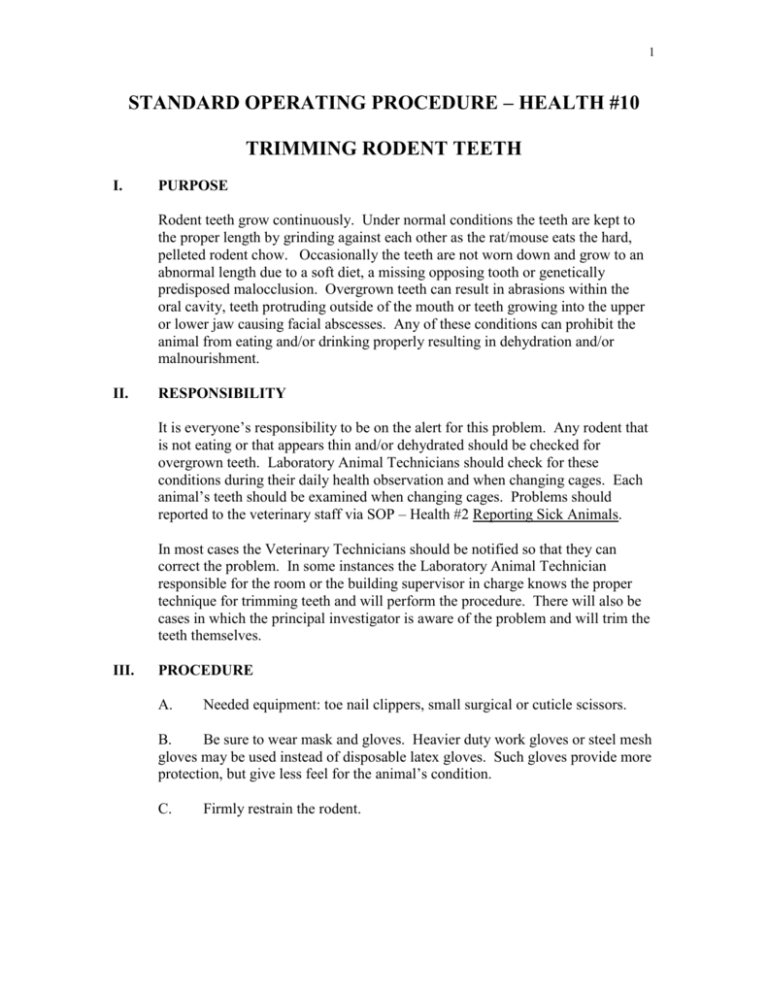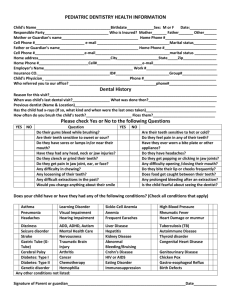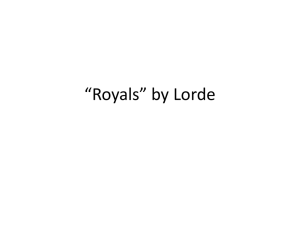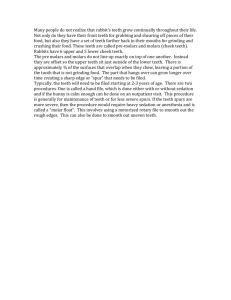sample SOP 1 - Workforce Solutions
advertisement

1 STANDARD OPERATING PROCEDURE – HEALTH #10 TRIMMING RODENT TEETH I. PURPOSE Rodent teeth grow continuously. Under normal conditions the teeth are kept to the proper length by grinding against each other as the rat/mouse eats the hard, pelleted rodent chow. Occasionally the teeth are not worn down and grow to an abnormal length due to a soft diet, a missing opposing tooth or genetically predisposed malocclusion. Overgrown teeth can result in abrasions within the oral cavity, teeth protruding outside of the mouth or teeth growing into the upper or lower jaw causing facial abscesses. Any of these conditions can prohibit the animal from eating and/or drinking properly resulting in dehydration and/or malnourishment. II. RESPONSIBILITY It is everyone’s responsibility to be on the alert for this problem. Any rodent that is not eating or that appears thin and/or dehydrated should be checked for overgrown teeth. Laboratory Animal Technicians should check for these conditions during their daily health observation and when changing cages. Each animal’s teeth should be examined when changing cages. Problems should reported to the veterinary staff via SOP – Health #2 Reporting Sick Animals. In most cases the Veterinary Technicians should be notified so that they can correct the problem. In some instances the Laboratory Animal Technician responsible for the room or the building supervisor in charge knows the proper technique for trimming teeth and will perform the procedure. There will also be cases in which the principal investigator is aware of the problem and will trim the teeth themselves. III. PROCEDURE A. Needed equipment: toe nail clippers, small surgical or cuticle scissors. B. Be sure to wear mask and gloves. Heavier duty work gloves or steel mesh gloves may be used instead of disposable latex gloves. Such gloves provide more protection, but give less feel for the animal’s condition. C. Firmly restrain the rodent. 2 1. MICE: Pick up the mouse by the base of the tail and with the thumb and index of the opposite hand tightly grasp the loose skin behind the neck area. This will help you control the animals head. Loop the tail around your little finger of the same hand that is restraining the neck. You should now have a firm grip on the mouse so that it cannot move his head to bite you. If held properly the animal will still be able to breath without difficulty. If the animal’s eyes begin to bulge, the animal is being held too tight. Picking up mouse by the base of the tail Restraining mouse for teeth clipping 2. RATS: Pick up the rat by the base of the tail. Reaching from behind the rat, place your hand on top of the rat with your index and middle fingers extending down the sides of the rats neck and behind the jaws thus controlling head movement. Your thumb and remaining fingers should grasp the rat’s body behind its forelegs to maintain control of the body movement. If the animal’s eyes begin to bulge, the animal is being held too tight. Picking up rat by base of tail 3 Restraining rat for teeth clipping D. With your free hand and using the toenail clippers or scissors position the instrument first on the top two front teeth about the area where the teeth should end and cut firmly. Care must be taken to prevent injury to the animal’s tongue. Repeat the technique on the bottom front teeth. 1. Trim the teeth enough to restore a normal bite, i.e. so the upper and lower teeth align correctly. View the bite of a normal animal to gauge how much tooth should be cut. 2. Do not attempt to cut an animal’s teeth without guidance and training from a person familiar with the procedure. IV. NEEDED EQUIPMENT Toenail clipper Small surgical or cuticle scissors IV. SAFETY CONSIDERATIONS Be sure to wear a mask and gloves when handling the animal and use proper handling techniques. If you loose your grip on the rodent return the animal to its cage and start over, allowing the animal to calm down. The rats/mice will usually do some struggling during the procedure. The procedure may necessitate the help of a second person when working with difficult animals V. NEEDED DOCUMENTATION None VII. REFERENCES SOP - Reporting Sick Animals








